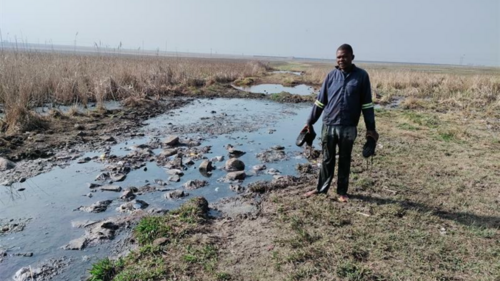News
Observing the Rietspruit Contaminated by Sewage Spill

On August 24, Wayne Hinde, a local resident who frequently cycles in the area and the Brakpan Herald, visited a remote section along the Rietspruit between Witpoortjie and Rooikraal. Their visit was prompted by Hinde’s concern about a significant sewage leak that was contaminating the Rietspruit and a nearby wetland. The leak originated from a concrete manhole, creating a pond of raw sewage.
Also Read: JMPD Personnel Sent to Fire-Damaged Building in Johannesburg CBD
When the Herald arrived at the site, the sewage flow had decreased, although it had not been repaired. It was suspected that the manhole cover had become clogged with sewage, preventing water from escaping. This particular manhole had been a recurring problem, leaking raw sewage intermittently for years, even before the onset of the Covid-19 pandemic.
Hinde, who had been monitoring the situation, described the overflow as a severe ecological disaster, with hundreds of litres of raw sewage flowing into the area per minute. He also expressed concern about the placement of a sewerage line in the middle of a floodplain, emphasising the potential cost of restoring the sewerage system and the affected area.
In addition to the sewage spills, Hinde believed that mining activities, particularly the cleaning of mining heaps, had further contributed to the contamination of the Rietspruit. The cleaning process involved using a significant amount of water, which then ran off into the stream. Hinde lamented the impact on the local wildlife, noting a significant decline in various species over the years, including jackals, duikers, rabbits, and mice. He described the valley as being predominantly tainted by sewage.
According to the Department of Agriculture, Forestry, and Fisheries website, studies indicate that South Africa has lost or severely degraded 35% to 60% of its wetlands. Recognising the importance of wetlands and floodplains to the ecosystem, the Working for Wetlands initiative was launched as a collaborative effort between the Departments of Environmental Affairs, Water and Sanitation, and Agriculture, Forestry, and Fisheries. This initiative aims to rehabilitate and protect wetlands, implementing strategies for their conservation and restoration.
The South African government policy underscores the need for a multifaceted approach that combines proactive measures to maintain healthy wetlands with efforts to reverse historical degradation, emphasising the significance of wetland conservation in the country.
Take a look at the video below:
Source: WATCH: Sewage spill runs into Rietspruit
Also Read:
Follow us on Google News
Photo: Supplied by Brakpan Herald

















